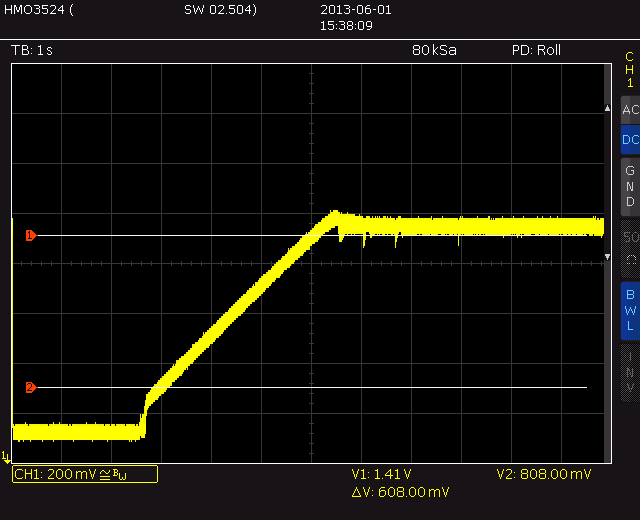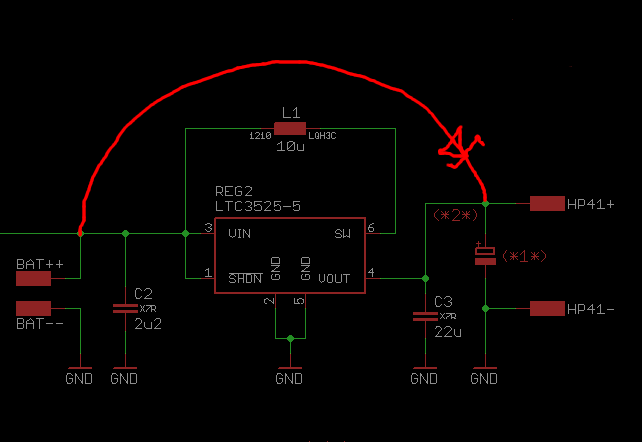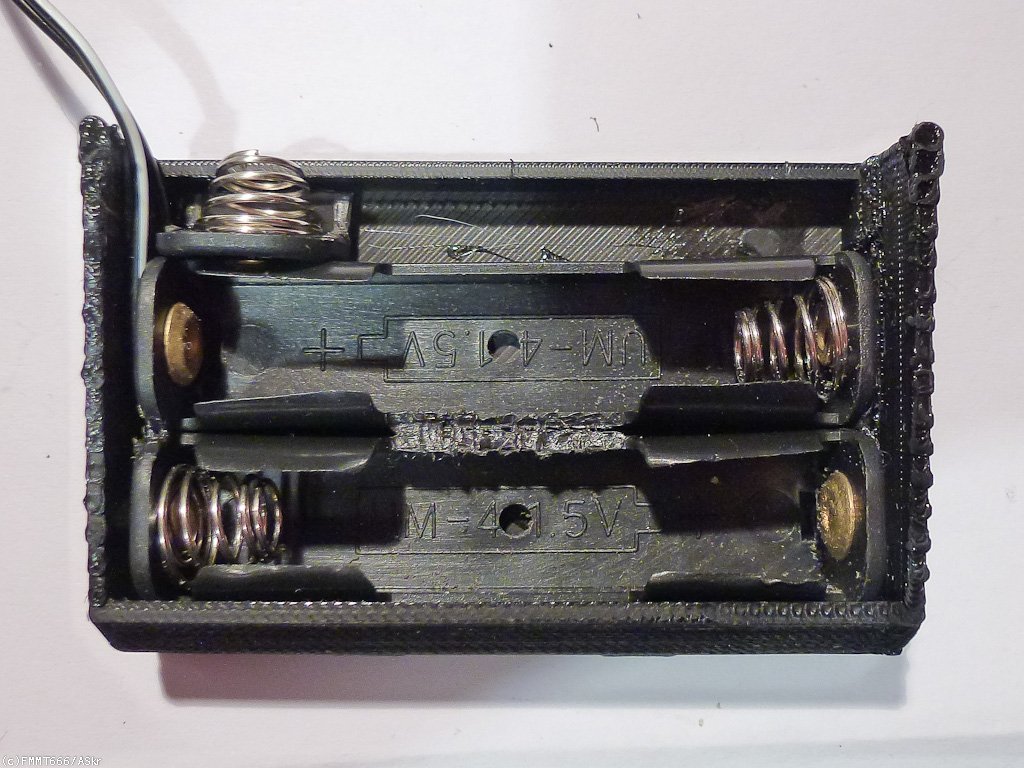Although this project is labeled "HP-41", it can be used for thousands of other things.
It consists of two different and independent circuits on a single, but dividable PCB:
- A Li-Ion charger for 4.3V - 6.4V inputs (e.g. USB).
- A step-up regulator for 2.0V - 4.5V inputs, boosted to 5.0V output
Features:
- <<1uA quiescent current
- 15uA @ Uin=3.0V with HP-41 turned on
- completely 3D printable HP-41 battery case
- complete and non-invasive battery replacement solution
- power HP via 1 x old Li-Ion phone battery
- power HP via 2 x NiMH batteries
- charge via USB (note: Li-Ion only!)
*burp*
Hardware
Overview
|
NiMH example (open top case) 
|
Electronics
V2.0 schematic...
|
...and layout
|
CHANGES V2.0:
- holes for external capacitor in "HP41+/-" output pads
(deleted all the babble, here...)
The circuit consists of two subunits:
- a phone battery (LiIon) charger, USB capable
- a 5V step-up regulator
For 2xNiMH or non-chargeable phone battery operation, only the second, right part is needed.
If you want your USB port to be able to charge the Li-Ion battery, build the first, left part too.
WARNING #2: DO ONLY USE LI-ION PHONE BATTERIES
Li-Ion phone batteries are internally protected against short-circuits and undervoltage. Do not use any other, unprotected Li-Ion cell!
No tricks and no magic here. Just a combined buildup of an LTC4054-4.2 stand-alone Li-Ion charger and an LTC3525, a 400mA step-up regulator.
The layout nicely fits on a single, (21x12)mm layer PCB.
That damn USB mech spec 8-/
Unfortunately, the designers of the HP-41 didn't consider the usage of an USB cable to charge
the calculator.
Even more surprising: The USB cable and plug specifications didn't consider the HP-41 too...
What does this mean?
Well, non of the USB cables that I found, fits through the hole on the side of the HP-41, so
it didn't make sense to build in a type B receptacle...
And that folks, is exactly why the layout only contains two flat pads with holes for a 5.08mm
header (3 pin, 2.54mm; middle pin cut).
Drawback: A special USB to pin header adapter is required...
...
Sh*t happens
After the circuit was built, tested and measured, I hooked up the 2xNiMH version to an HP-41, turned it on and - well - nothing happened...
As it turned out, the HP-41 contains a quite large capacitance. Because of the charge distribution
from the small step-up converter's output capacitor (22uF) to an obviously much larger value, the
output voltage dropped below "the point of no return". Together with the HP-41's quiescent current,
higher at this low level voltage, the switching regulator was not able to leave this state.
The current demand at the output was too high.
For an approximation of the HP-41 internal capacitance, that had to be overcome, I powered it up with
constant current of 100uA.
With the measured slew rate of ~600mV/3s, the internal capacitance can easily be approximated:

Wow, a 470uF cap. I didn't expect this...
As is turned out, the regulator was able to power up if the voltage drop did not undershot ~2V.
With a capacitance equal to the value of the HP-41's internal one, the voltage won't drop below ~2.5V
and the regulator will always work.
The type (or ESR) of this external capacitor is not important, but obviously: Size is!
It won't be too hard to find an appropriate 470uF, 6V3 capacitor in a 6.3mm x 11mm package, there
are dozens of them available.
Notice that this start-up problem only occurs only once, at the point the battery is inserted into
a completely discharged HP-41.
It is not caused by turning on the calculator and won't show up afterwards...
As an alternative for the Li-Ion variant, you could also wire a schottky diode from BAT++ to HP41+:
Performance/Measurements
Just some quickly typed in data, so far:
Quiescent current:
- <<1uA quiescent current with HP-41 turned off
- 15uA @ Uin=3.0V with HP-41 turned on
- 17uA @ Uin=4.0V with HP-41 turned on
Efficiency @ 3.3V input (Li-Ion med):
(notice that a HP-41 never draws that much current...)
- 10mA 93%
- 20mA 93%
- 100mA 90%
...
Mechanics
one part, open top compartment
|
standard, two part battery compartment
|
same as above with closed side
|
Three different types of cases are available:
- a one part case with an open top for NiMh batteries
- a two part case with an open side for a plug
None of them contains any mounting holes or other kind of attachments for batteries, the PCB or HP-41 contacts. Use your brain, imagination and hot glue...
The "open top", single part variant is intended to be used with two AAA battery holders. A "two part" case was developed for phone batteries, which do not need to be taken out.
I tried a lot to create my own, custom HP-41 battery contacts, but in the end, two cut off springs from cheap AAA battery holders turned to be out the best solution.
For 3D printing:
Please notice that the one part case, as well as the bottom piece of the compound case need support
structures below the overhanging edge and the snap-in detent.
Some Useless Pics
Download
DOWNLOAD: HP-41Bat_hard_v20.zip Hardware, V2.0DOWNLOAD: HP-41Bat_mech_v10.zip Mechanics, V1.0 (upd. 7/2013)













